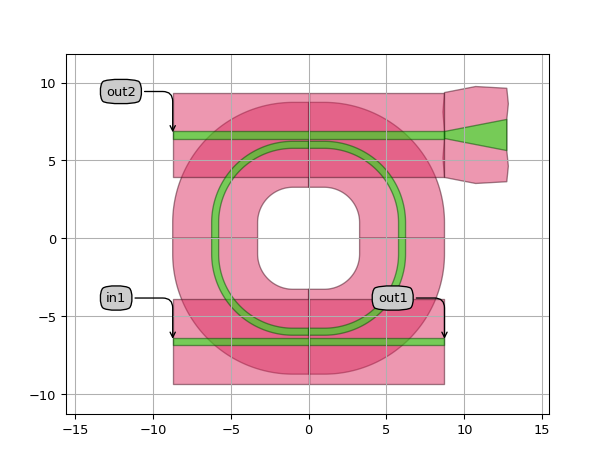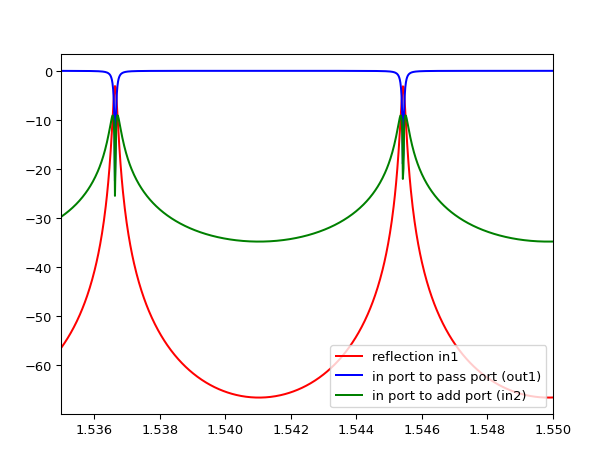TerminatePorts
- class picazzo3.container.terminate_ports.TerminatePorts
Wraps a PCell in a container and terminates the ports specified by the user. If None is given for the port_labels, all ports will be suppressed.
You can also provide another PCell to the property ‘termination’ which will be attached to each terminated port (a stub, to remove reflections). If None is provided, a logical termination is added to the Netlist, but no termination is added in the layout.
- Parameters:
- termination_external_port_name_map: str
dict to map the names of the termination ports that are exposed as external ports. The format is { ‘port_name_on_termination’ : ‘new_name_{port}’ }. The ‘{port}’ in the map will be replaced by the corresponding port name on the component.For instance, when you use grating couplers or detectors as terminations, this map allows you to map the name of the vertical port or the electrical ports to the name of the terminated port on the contents. Similarly, you can use {inst} to insert the name of the instance of the termination. By default, the behavior is ‘{inst}_{port}’.
- termination_port_label: str and String that contains only ISO/IEC 8859-1 (extended ASCII py3) or pure ASCII (py2) characters
label of the port on the termination that will be used to connect to the part of the contents. Default is ‘in’
- termination: PCell
cell which will be used to terminate the ports
- trace_template: ( PCell and _WaveguideTemplate ), *None allowed*
Template for all ports, defaults to TECH.PCELLS.WG.DEFAULT.When set to None, the waveguide templates of the ports will be used.
- termination_instance_prefix: String that contains only alphanumeric characters from the ASCII set or contains _$. ASCII set is extended on PY3.
Prefix for the instance names of the terminations. Default is taken from TECH.CONTAINER.TERMINATE_PORTS
- auto_transition:
If True, automatically transition all ports of contents to the given trace template. If False, no transitions are applied, which might lead to a discontinuity in the waveguide. Also, if trace_template is None, no transitions are applied.
- port_labels: ( List with type restriction, allowed types: <class ‘str’> ), *None allowed*
Labels of the ports to be processed. Set to None to process all ports.
- external_port_names: str
Dictionary for remapping of the port names of the contents to the external ports
- contents: PCell
the contents of the container: the child cell
- name: String that contains only ISO/IEC 8859-1 (extended ASCII py3) or pure ASCII (py2) characters
The unique name of the pcell
- Other Parameters:
- termination_external_port_name_maps: locked
- termination_port_labels: locked
- terminations: List with type restriction, allowed types: <class ‘ipkiss3.pcell.cell.pcell.PCell’>, locked
- trace_templates: List with type restriction, allowed types: <class ‘ipkiss3.pcell.cell.pcell.PCell’>, locked
list of templates to apply to all ports
Examples
"""Layout example of terminated ring resonator""" import si_fab.all as pdk # noqa: F401 from picazzo3.filters.ring import RingRect180DropFilter my_ring = RingRect180DropFilter() my_ring.Layout() from picazzo3.container.terminate_ports import TerminatePorts # Optionally we can add a structure where the ports are suppressed from picazzo3.apertures.basic import WireWgAperture from picazzo3.traces.wire_wg import WireWaveguideTemplate wire_t = WireWaveguideTemplate() wire_t.Layout(core_width=2.0, cladding_width=6.0) my_termination = WireWgAperture(name="my_termination", aperture_trace_template=wire_t) my_termination.Layout(transition_length=4.0) my_ring_terminated = TerminatePorts(contents=my_ring, port_labels=["E1"], termination=my_termination) my_ring_terminated_layout = my_ring_terminated.Layout() my_ring_terminated_layout.visualize(annotate=True)

"""Simulation example of terminated ring resonator""" import si_fab.all as pdk # noqa: F401 import numpy as np from picazzo3.filters.ring import RingRect180DropFilter from picazzo3.container.terminate_ports import TerminatePorts from picazzo3.logical.termination import Termination import matplotlib.pyplot as plt my_ring = RingRect180DropFilter() cp = { "cross_coupling1": 1j * 0.05**0.5, # The coupling from bus to ring and back "straight_coupling1": 0.95**0.5, # Straight coupling } my_ring.CircuitModel(ring_length=2 * np.pi * 10.0, coupler_parameters=[cp, cp]) my_termination = Termination() my_termination.CircuitModel(reflection=0.5**0.5) my_ring_terminated = TerminatePorts(contents=my_ring, port_labels=["W1"], termination=my_termination) my_ring_terminated.Netlist() my_ring_terminated_cm = my_ring_terminated.CircuitModel() wavelengths = np.linspace(1.535, 1.55, 800) R = my_ring_terminated_cm.get_smatrix(wavelengths=wavelengths) plt.figure() plt.plot(wavelengths, 10 * np.log10(abs(R["in1", "in1"] ** 2)), "r-", label="reflection in1") plt.plot(wavelengths, 10 * np.log10(abs(R["in1", "out1", :] ** 2)), "b-", label="in port to pass port (out1)") plt.plot(wavelengths, 10 * np.log10(abs(R["in1", "in2", :] ** 2)), "g-", label="in port to add port (in2)") plt.xlim([wavelengths[0], wavelengths[-1]]) plt.legend() plt.show()

Views
- class Layout
- Parameters:
- termination_transformations: List with type restriction, allowed types: <class ‘ipkiss.geometry.transforms.no_distort.NoDistortTransform’>
Transformations of the terminations. By default, these are calculated to match the ports of the contents.
- contents_transformation: GenericNoDistortTransform
transformation to apply to the contents
- flatten_contents:
if True, it will insert the contents as elements in the layout, rather than as an Instance
- view_name: String that contains only alphanumeric characters from the ASCII set or contains _$. ASCII set is extended on PY3.
The name of the view